
94% of researchers rate our articles as excellent or good
Learn more about the work of our research integrity team to safeguard the quality of each article we publish.
Find out more
SYSTEMATIC REVIEW article
Front. Neurol., 13 November 2020
Sec. Movement Disorders
Volume 11 - 2020 | https://doi.org/10.3389/fneur.2020.591605
Objective: Initial randomized controlled trials (RCTs) and recently released systematic reviews have identified resistance training (RT) as a modality to manage motor symptoms and improve physical functioning in individuals with Parkinson's disease (PD), although the effects are inconsistent. Therefore, we conducted an updated meta-analysis to reassess the evidence of the relationship.
Methods: We performed a systematic search of studies reporting the effects of RT in PD available through major electronic databases (PubMed, Medline, Embase, Ovid, Cochrane Library, CNKI, Wanfang) through 20 July 2020. Eligible RCTs were screened based on established inclusion criteria. We extracted data on the indicators of leg strength, balance, gait capacity, and quality of life (QoL) of lower limbs. Random and fixed effects models were used for the analysis of standard mean differences (SMD) or mean differences (MD) with their 95% confidence intervals (CI).
Results: Thirty-one papers from 25 independent trials compromising 1,239 subjects were selected for eligibility in this systematic review and meta-analysis. Summarized data indicated that the leg strength increased statistically significant in PD patients (SMD = 0.79, 95% CI 0.3, 1.27, P = 0.001), the balance capability was improved statistically significant in PD patients (SMD = 0.34, 95% CI 0.01, 0.66, P = 0.04), and QoL statistically significantly improved (MD = −7.22, 95% CI −12.05, −2.39, P = 0.003). For gait performance, four indicators were measured, the results as follows: fast gait velocity (MD = 0.14, 95% CI 0.06, 0.23, P = 0.001), Timed-up-and-go-test (TUG, MD = −1.17, 95% CI −2.27, −0.08, P = 0.04) and Freezing of Gait Questionnaire (FOG-Q, MD = −1.74, 95% CI −3.18, −0.3, P = 0.02) were improved statistically significant across trials, while there were no statistically significant improvement in stride length (MD = −0.05, 95% CI −0.12, 0.02, P = 0.15) in PD patients.
Conclusions: Lower limb RT has positive effects during rehabilitation in individuals with PD in leg strength, QoL, and improve gait performance to a certain extent. RT also could improve balance capacity of patients, although a wide variety of tools were used, and further study is needed to confirm these findings.
Parkinson's disease (PD) is a highly prevalent and progressive degenerative disorder of the nervous system, primarily affecting the middle-aged and elderly. Approximately 1% of people 60 years and older are affected (1–3). The estimated prevalence of PD is expected to double by 2040, with prevalence in USA alone over 1.6 million, due mainly to changing demographic profiles and increasing of life expectancy (4, 5). Clinical symptoms of PD include motor symptoms and non-motor symptoms. The classic tetrad of Parkinson's symptoms includes—resting tremor, bradykinesia, rigidity, and loss of postural reflexes. These motor difficulties bring about decreased muscle strength and increased tension in the lower limbs, further impairing balance performance and seriously affecting standing and walking postural instability (6). Postural instability increases the risk of falling and fear of falling, and often results in increased sedentarism, resulting in poor quality of life (QoL) (7, 8). Non-motor symptoms include anxiety, depression, neuropsychiatric symptoms, and sleep disturbances, also negatively impacting the quality in patients with PD life in addition to the motor symptoms (9, 10).
Presently, treatment for PD is limited to symptomatic management and etiological management remains under development. Exercise training has strong evidence supporting its use to alleviate motor dysfunction and physical discomfort in PD and could improve cognitive function, drug efficacy, sleep patterns, and mitigate depression (11), and has therefore attracted substantial clinical interest. Exercise therapies (12, 13) include passive exercise methods such as acupuncture and massage, and active exercise methods such as Yoga and Tai Chi. The above modalities rely on the guidance of doctors and coaches to vary degrees, and have high requirements for patient compliance. However, some studies have reported resistance training (RT) as a method to increase muscle length and enhance muscle strength by overcoming external resistance, which can be conducted at home after patient training. Compared with other physical training methods, it is more practical and flexible for a wide variety of patient lifestyles (14, 15). Accumulating evidences indicate that RT improves balance, gait performance, and lower limb muscle strength in PD (8–12, 14). A recent study of multicentered, RCT indicated the effectiveness of an 8-week stretching and RT exercises program in 138 PD patients and concluded a clinically significant improvement in motor dysfunction and mobility, with a positive effect of physical and functional capacities (16). Vieira De Moraes Filho et al. (17) also revealed that RT reduces bradykinesia, motor symptoms, and improves functional performance in patients with PD. Currently, the mechanism of RT on functional fitness and activities in persons with PD is unclear, some related studies show that RT improves the antioxidant capacity of patients, induces muscle hypertrophy, increases muscle cross-sectional area, muscle strength, endurance, effectively alters muscle shape, modifies the rates of motor neurons and the synchronization of motor units, as well as improves cognitive function (10, 18–21).
RT has been proven to improve the strength, some physical functionality, and motor function in patients with PD, and is widely used in clinical non-drug treatment for PD (22, 23). However, the results of recent meta-analyses were different, even conflicting, especially in the improvement of gait and balance (24, 25). A previous meta-analysis by Tillman et al. (24) reported that RT increased leg strength but not gait performance or balance in subjects with PD, although the studies included in this review were limited, with limited numbers of patients in each trial (24). Recently, various studies have found improvements in functional capabilities as a result of RT (23, 26). Thus, considering the inconsistent results, our objective was to reassess the existing uncertainty in regard to evidence supporting the effects of RT on gait and balance in subjects with PD by conducting a new systematic review and meta-analysis of extant RCTs.
We systematically searched available literature reporting on subjects with PD undergoing RT in several electronic databases including PubMed, Medline, Embase, Ovid, Cochrane Library, China National Knowledge Infrastructure (CNKI) and Wanfang until revised: 20 July 2020. Only English and Chinese studies were considered. Search terms among these studies were “Parkinson,” “Parkinson's disease,” “PD,” “Parkinsonism,” “resistance training,” “strength training,” “power training,” and “controlled clinical trials.” References of published articles were also checked during the selection of literature initially retrieved in our study. A flow diagram in Figure 1 displays the retrieval process and results.
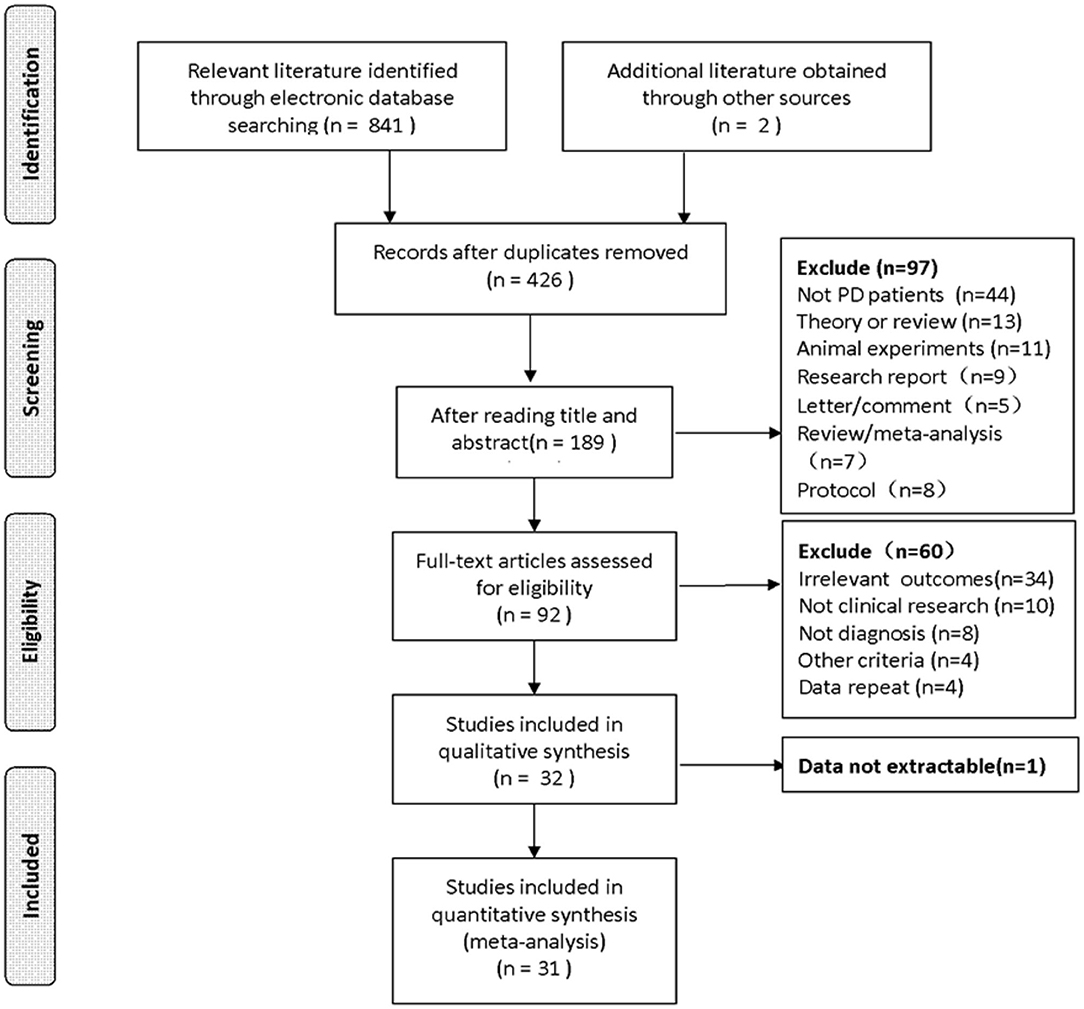
Figure 1. Flow diagram of literature selecting process and results according to the preferred reporting items for the meta-analysis. PD, Parkinson's disease.
Studies included in this review were required to meet the following criteria for inclusion: (1) the study utilized an RCT design and assessed the effects of RT in subjects with PD, which included RT against other exercise or no motor intervention. Studies that combined RT with other exercise but could independently assess the effectiveness of RT were also included in the study; (2) RT was focused on the lower limbs; (3) the outcomes considered at least one aspect of strength and physical function, including gait performance, balance, leg strength, or QoL; (4) full text of the article was published in English or Chinese. Studies that met the following conditions were excluded: (1) studies that were conducted on the effects of mixed exercise beyond RT only, and could not solely evaluate the effect of RT in PD; (2) studies for which the full text or main results were unavailable; (3) studies which were case reports, protocols, animal studies, qualitative analyses, reviews, or commentary. Based on the eligibility criteria, XYL and JH independently screened titles and abstracts and read the full text of included literature. If two or more trials were reporting on identical cohorts, the article published most recently, or which was the most comprehensive was retained.
The basic data and clinical characteristics were gathered as follows: author, country, publication year, sex ratio, age, sample size, disease stage (Hoehn-Yahr Stage), disease duration, frequency and intervention time, follow-up period, outcome measures, and intervention of different group. Two authors XYL and JH, independently extracted the data and cross-checked the information; discrepancies were resolved through discussion or consultation with another experienced author JY until a consensus was reached. Quality of the included articles was evaluated using the bias risk assessment from the Cochrane collaboration Network, which included whether the random allocation method was correct, whether the allocation was hidden, whether blinding methods were used, whether there was loss of follow-up, the presence of selective reporting biases, or other biases.
The outcome measures adopted in our meta-analysis were direct quantitative scores provided by preliminary studies. We evaluated the efficacy of RT on subjects with PD in the following aspects. First, leg strength in kilograms or Newtons was assessed by one repetition maximum (1-RM) leg press strength, strain gauge or force platform assessing the lower limbs. Second, balance capability was assessed with different tools, including the Berg scale, Fullerton Advanced Balance (FAB) scale, Balance Evaluation Systems Test (BESTest), Mini-best and Coordinated stability test. Third, gait performance was evaluated by stride length, fast gait velocity (which could be measured by 6- or 10-m walking tests, second chronograph and computer), Timed-up-and-go-test (TUG) and freezing of Gait Questionnaire (FOG-Q). Finally, QoL was assessed by the Parkinson's Disease Questionnaire (PDQ-39).
Revman 5.3 and Stata 12.0 software were utilized to conduct the meta-analysis. Pooled mean difference (MD)/standard mean difference (SMD) and 95% confidence intervals (95% CI) were calculated for continuous variables to compare the different effects of resistance training in subjects with PD between experimental and control groups. The heterogeneity of the results was analyzed by the Cochrane-Q-test and I2-statistic (values of 25, 50, 75%, respectively, represented degrees of heterogeneity at low, moderate, and high levels.). If P > 0.1, I2 < 50% indicated that the studies were homogeneous and a fixed effects model could be adopted; otherwise, a random effects model was necessary. Obvious heterogeneity was processed by sensitivity analysis or only descriptive analysis. The publication bias was analyzed by Egger's test and Begg's test to assess quantitative evaluation results.
The detailed literature retrieval process in the study can be found in Figure 1. The preliminary search yielded 843 records, which was reduced to 426 articles after the exclusion of duplicates. Two authors screened titles and abstracts, and 237 articles were excluded for irrelevance to the topic. The 189 remaining literature were carefully evaluated by full-text review; 92 articles were considered suitable for the inclusion. After removing articles with irrelevant outcomes or criteria, and 1 article for which reliable data could not be extracted, 31 eligible articles from 25 independent trials were assessed for final eligibility and included in this meta-analysis.
Thirty one papers compromising 1,239 subjects were selected for eligibility in this systematic review and meta-analysis (7, 9, 10, 13, 16, 17, 23, 26–49). Table 1 contains the general characteristics of the included articles between the experimental groups and controls in individuals with PD. These articles were all RCTs and published from January 2000 to July 2020. The bias risk assessment results of the included articles are presented in Figure 2. Fifteen of the studies with target population were from the Americas (8 from North America and 7 from South America), 4 studies were from Europe, 3 studies were from Oceania, and 3 studies were from Asia. Twenty nine of these studies were published in English and 2 were published in Chinese. The sample size of each publication varied between a low of 15 and a maximum of 138. The average age of included subjects from each article varied from 58.8 to 79.5. The medical diagnosis, disease stage, and inclusion and exclusion criteria of patients were adequately reported among the included studies. Subjects involved in these studies were mostly mild to moderate PD according to the Hoehn and Yahr Staging Scale of 1–4. To further explore extreme heterogeneity, we performed a detailed descriptive analysis.
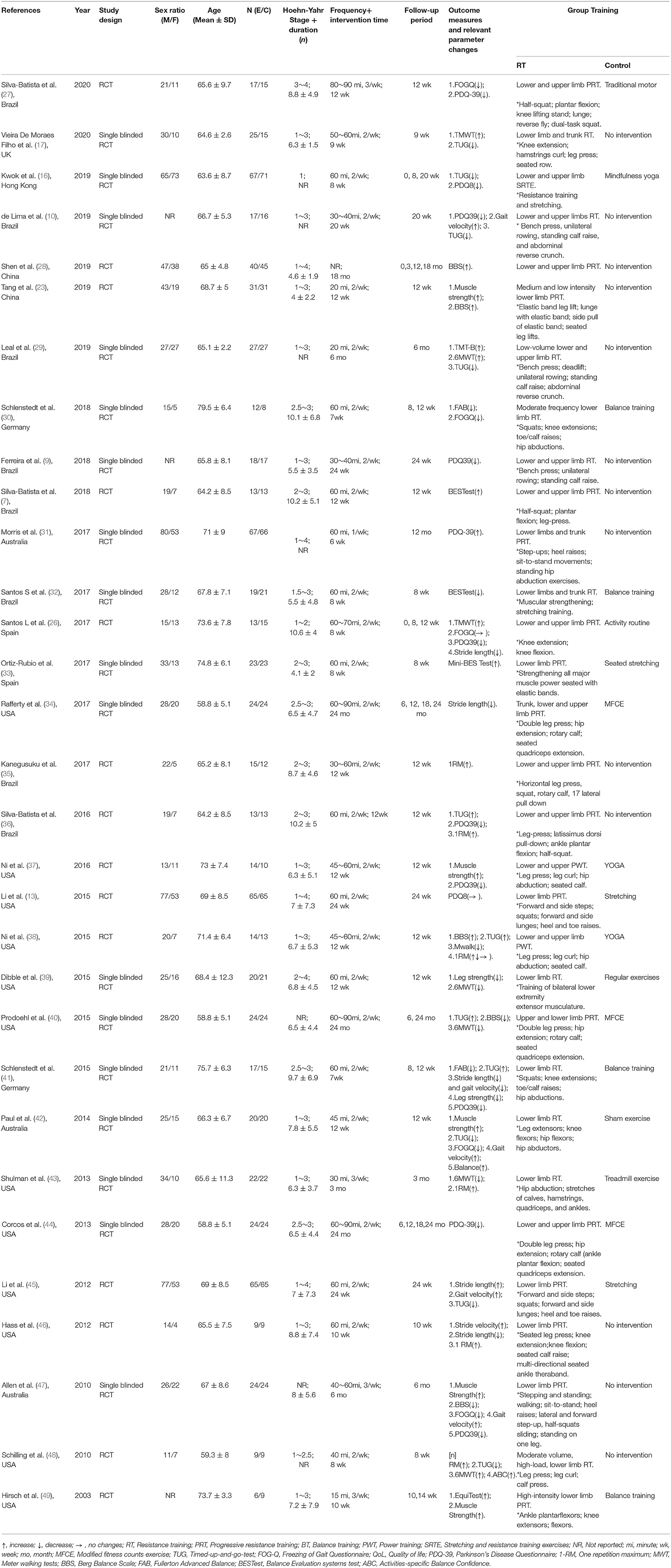
Table 1. General characteristics of these included articles concerning the effects of lower limb RT in individuals with PD.
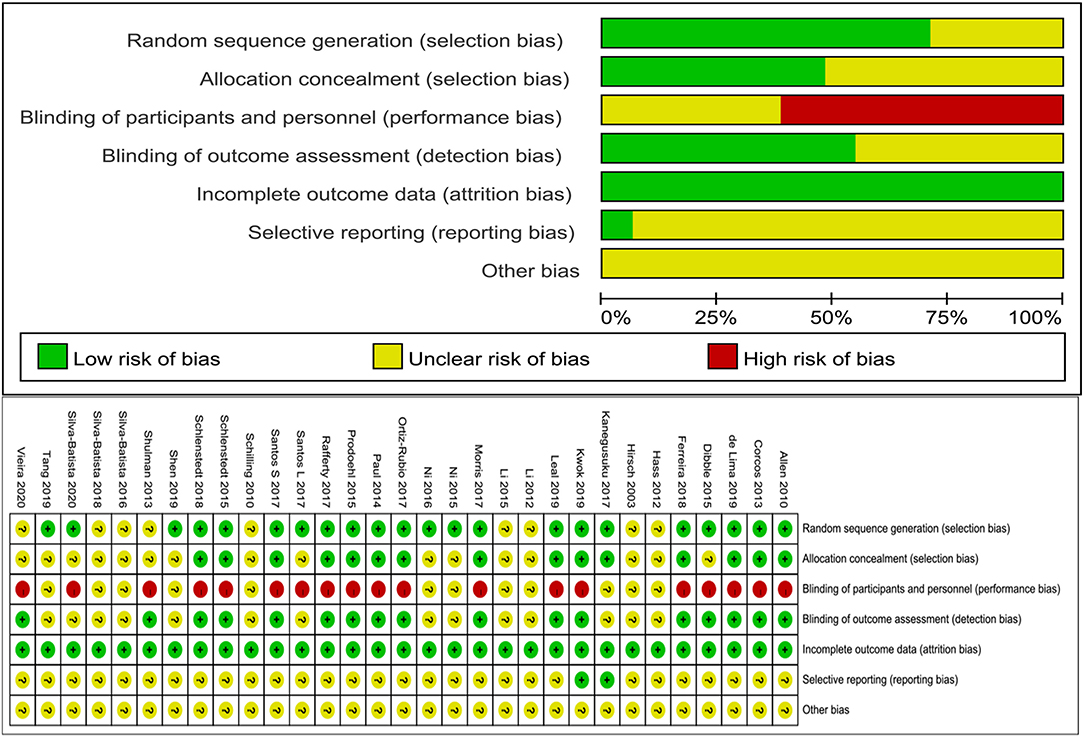
Figure 2. Quality of the included articles by the bias risk assessment based on the Cochrane collaboration Network.
Among the included publications, 13 discussed muscle strength of the lower limbs, and two articles (37, 38) were from the same study, so we adopted the data from the latest one. Therefore, 12 articles involving 377 subjects informed the analysis. Summarized data presented that the leg strength increased significantly in the experimental group compared to the control group (SMD = 0.79, 95% CI 0.3, 1.27, P = 0.001), indicating a positive effect of RT on strength in the lower limbs. In consideration of high heterogeneity between articles (P < 0.00001, I2 = 78%), a random-effects model was conducted to pool the data (Figure 3).
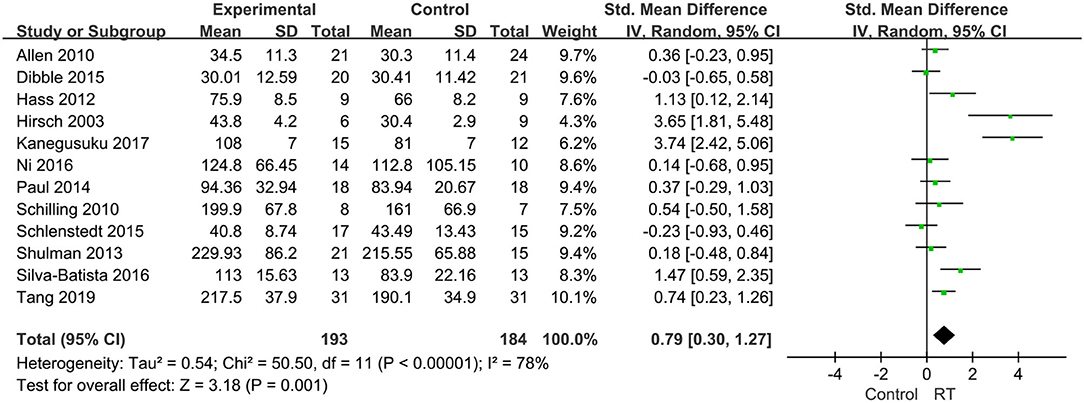
Figure 3. Forest plots of the effects of lower limb RT on leg strength in PD. CI, confidence interval.
Fourteen of all included literature reported the effectiveness of RT on balance performance in individuals with PD, while two papers (30, 41) reported on the same study, we chose the article with the larger sample size for this analysis. Therefore, there were 13 articles compromising 536 patients involved in the analysis. The pooled effects displayed that balance capability in experiment group improved after the RT compared to that in the control group (SMD = 0.34, 95% CI 0.01, 0.66, P = 0.04). There was moderate heterogeneity between studies (P < 0.0001, I2 = 70%) and a random-effects model was used to pool the data (Figure 4). These results suggested that RT could be beneficial for improving balance in PD.
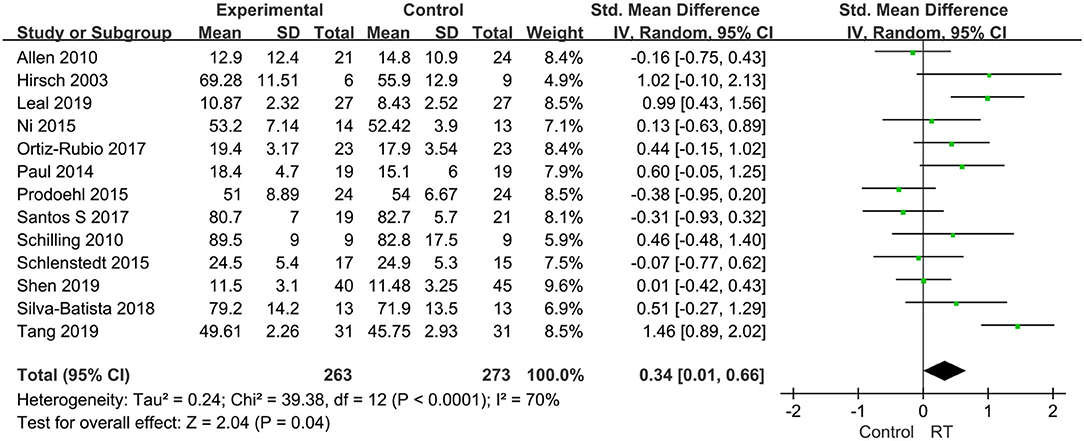
Figure 4. Forest plots of the effects of lower limb RT on balance performance in PD. CI, confidence interval.
Eighteen articles compromising 818 subjects evaluated the effects of RT on gait performance in PD, and mainly focused on the following four aspects: stride length, fast gait velocity, TUG, and FOG-Q. ① Stride length was measured in five articles with 251 subjects. We set the parameter m as the unified unit of measurement. Pooled effects revealed that the stride length was not significantly different between the pooled experimental group and control group (MD = −0.05, 95% CI −0.12, 0.02, P = 0.15), with high heterogeneity between studies (P = 0.01, I2 = 70%) by a random-effects model to obtain the results (Figure 5). ② Fast gait velocity was measured in 13 articles with 573 subjects, and we set the parameter m/s as the unified unit of measurement. The pooled effects displayed that the fast gait velocity was significantly different between the pooled experimental group and control group (MD = 0.14, 95% CI 0.06, 0.23, P = 0.001), with moderate heterogeneity between studies (P = 0.0002, I2 = 68%) by a random-effects model to obtain results (Figure 6). ③ The TUG was measured in 11 articles compromising 584 patients, and we set the parameter s as the unified unit of measurement. The pooled effects demonstrated that the TUG time in experimental group was significantly quicker than in the control group (MD = −1.17, 95% CI −2.27, −0.08, P = 0.04) with high heterogeneity between studies (P < 0.00001, I2 = 84%) requiring a random-effects model to determine the results (Figure 7). The high heterogeneity could be related to different stages of disease and non-uniform training programs. ④ The FOG-Q was measured in 5 articles compromising 163 patients. The pooled effects showed that there was a significant difference in FOG-Q score between the experimental group and the control group (MD = −1.74, 95% CI −3.18, −0.3, P = 0.02) with low heterogeneity between studies (P = 0.1, I2 = 48%) allowing a fixed-effects model to determine the result (Figure 8). These indicators of gait performance indicated that RT could improve fast gait velocity, TUG and freezing of gait, but potentially not stride length.

Figure 5. Forest plots of the effects of lower limb RT on gait performance—stride length in PD. CI, confidence interval.
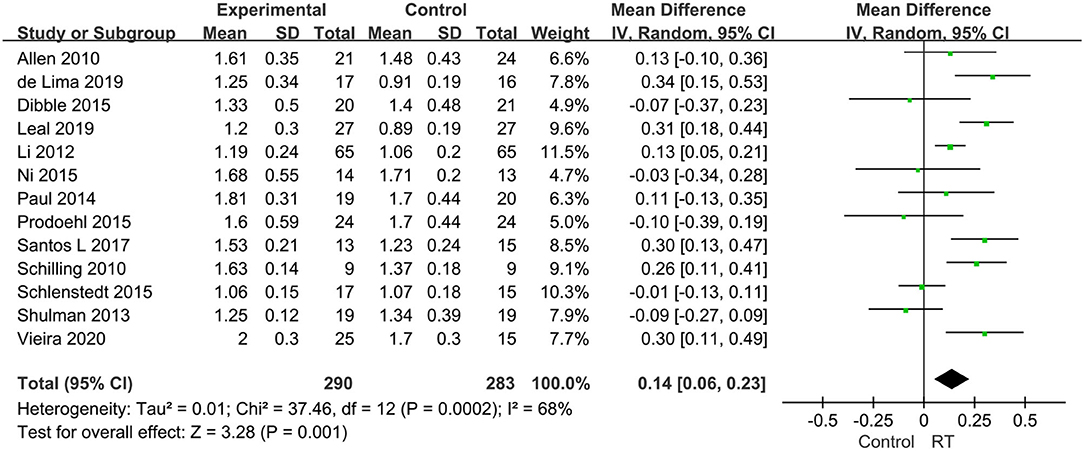
Figure 6. Forest plots of the effects of lower limb RT on gait performance—fast gait velocity in PD. CI, confidence interval.
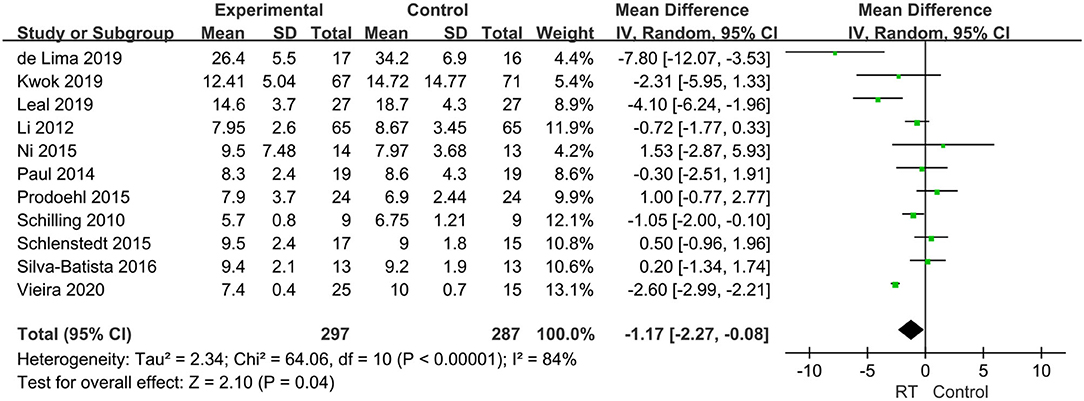
Figure 7. Forest plots of the effects of lower limb RT on gait performance—timed-up-and-go-test in PD. CI, confidence interval.

Figure 8. Forest plots of the effects of lower limb RT on gait performance—freezing of gait in PD. CI, confidence interval.
There were 12 articles measuring health-related QoL in subjects with PD. The score item in one study was the Parkinson's Disease Questionnaire (PDQ-8), and in one another study was a disease-specific 8-item PDQ (Chinese version). All other studies used the PDQ-39. To ensure the consistency of results, we combined the data from the PDQ-39 only. Ten studies with 436 subjects were involved in this analysis. The pooled effects analysis revealed that patients in the experimental group had significantly lower PDQ-39 scores than in the control group (MD = −7.22, 95% CI −12.05, −2.39, P = 0.003) with moderate heterogeneity between studies (P = 0.0003, I2 = 71%) requiring a random-effects model to determine the result (Figure 9), suggesting that RT has a positive effect on the QoL in individuals with PD.
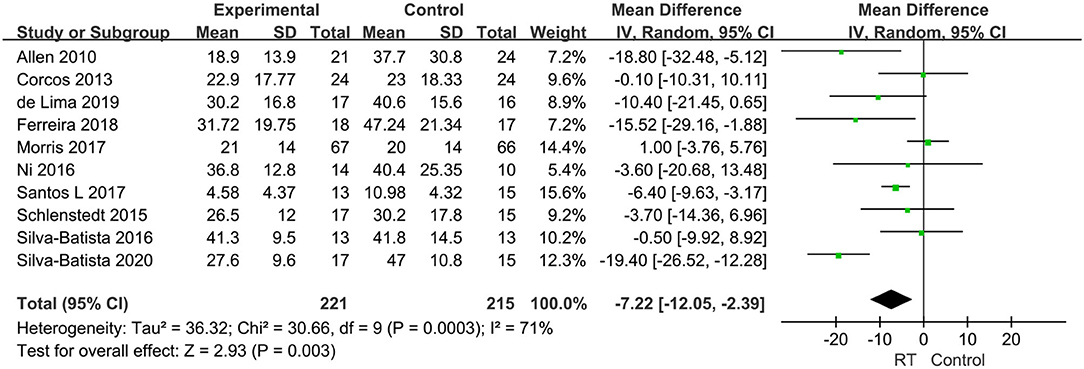
Figure 9. Forest plots of the effects of lower limb RT on quality of life in PD. CI, confidence interval.
We used the fast gait velocity analysis, which included in the most literature, as an example to conduct sensitivity analysis and publication bias. Sensitivity analyses suggested that no single study could affect the total effect size by omitting the articles one-by-one. The shape of the funnel plot (Figure 10) was generally symmetric in the overall publication, the data points were equally distributed around the funnel and no obvious small sample effects. These showed that no indication of significant publication bias was, respectively, found which is consistent with the Begg's test (P = 0.3 > 0.05) and Egger's test (P = 0.621 > 0.05) in the overall population.
In this updated systematic review and meta-analysis of RCTs, 31 eligible articles from 25 independent trials compromising 1,239 subjects were summarized to verify the effects of lower limb RT in PD. In general, the synthesis of the existing research identified positive effects in PD symptoms with RT. Our major findings suggested significant improvement in balance capacity, gait performance, and QoL, which appeared contradictory to previous systematic reviews (24, 25). This mainly due to that previous studies with limited studies were involved, while studies included in our study with larger sample size and wider population.
The results of our study were reliable and robust from the perspective of systematic review methods, which included the latest RCTs and more comprehensive evidence of the topic, with more diverse geographical areas covering North and South America, Europe, Asia, and Oceania, with a relatively larger sample size (n = 31), and the Cochrane risk of bias tool was used for quality assessment among included RCTs. Eighteen of the 31 included articles were single-blinded RCTs, and blinded assessors or blinded physiotherapists were engaged in the intervention process to ensure concealment of allocation or outcome assessment, which considering the nature of motor intervention that it would be hard to blind the subjects. It's not clear whether there is a practical blind method the remaining studies of both subjects and treatment teams in the therapeutic process. Thus, blinding seems to be the primary limitation in design and method of these current studies.
From the pooled analysis, it was concluded that RT could significantly increase leg strength in individuals with mild-to-severe PD over periods of 8 weeks−24 months. The results agree with the latest meta-analyses by Tillman et al. (24) and Roeder et al. (50). The main mechanism responsible is likely that RT results in strong stimulation of skeletal muscle protein synthesis, promotes muscle cell growth, improves skeletal muscle quality, causes cyclic assimilation hormone to induce increases in absolute muscle strength and muscle cross-sectional area ratios, and optimizes skeletal muscle innervation and activation, thus enhancing lower limb muscle strength in patients with PD (23, 50, 51). Muscle strength of the lower limbs in patients with PD is markedly reduced, which is related to mobility, falls risk (39) and increased mortality (35). Although training programs differed widely among the included studies (frequency: 15–90 min/session, 1–3 sessions/week; intensity: low-to-high volume; and duration: 6 weeks−24 months), all protocols were effective in improving strength, power and physical performance in older patients. Previous studies have suggested patients with PD experienced highly varied strength gains though RT, which could be affected by disease severity, baseline muscle strength or intensity, intramuscular fat, and neural activation (52, 53). While a recent systematic review by Lopez et al. (54) hold that no association between exercise type, RT duration, weekly volume and intensity, and fitness outcomes (i.e., muscle strength) in men with prostate cancer. Consistent with our results, Douris et al. (55) indicated a significant increase in leg strength in a recreationally active person with PD and found decreases in restless leg syndrome after 18-weeks of RT exercises.
Postural instability is a common symptom in patients with PD and is considered to be the most significant factor related to falls and increased morbidity (56). Current literature on the effects of RT on postural balance disorders in PD remains controversial; a meta-analysis by Chung et al. (25) demonstrated that RT can result in significant balance gains in mild-to-moderate PD, while Tillman et al. (24) suggested no discernable effect of RT on balance measures. Our study showed that the balance capacity of patients in the experimental group was better than that before exercise following training. Several plausible reasons could account for this: RT could increase the muscle strength and explosive force of the quadriceps femoris in patients with PD, improve the stability of knee joint, improve the strength and stability of the trunk muscles, regulate the sensitivity of the neuromuscular control system and sensation, improve neuromuscular control efficiency and posture control ability, and improve patients' balance ability. Hewitt et al. (8) supposed that after RT, PD patients in the experimental group improved in physical performance and functional mobility, with reduced falls and fall rates. In line with our results, significant improvements in balance-related activities of home-based prescribed exercise were also verified in another recent systematic review by Flynn et al. (57). We acknowledged that balance control is complex and involves many different underlying systems, many clinical tests were designed to use one single “balance system” and used one or two balance measuring tools, which themselves varied greatly. And since the subjects of included studies did not classify in different phenotypes, i.e., tremor dominate (TD), postural instability/gait disorders (PIGD), so it is impossible to know which phenotype in PD is more effective in balance capacity with RT. Additionally, one recent publication (58) have highlighted the variability in postural instability by genetic subtypes; given phenotypic severity with wide range and genetic data is increasingly more important than phenotypes, the included articles in our study did not assess greater granularity in genetic. The lack of uniformed balance measures, motor phenotypes and genetic analysis reported in RT intervention studies limits our analysis, we suggest the results may not be suitable for every PD patients with caution and there remains a need for further research to confirm this conclusion.
Gait performance is another crucial function of the lower limbs which usually affected by functional impairments in PD. Gait impairments are composed of motor defects, bradykinesia, stiffness, the postural instability characteristic of PD, and reduced the QoL. A prior review by Chung et al. (25) found no statistically significant effects of RT in patients with PD for gait performance, but our study suggested that RT could improve gait performance to a certain extent in PD. To understand the effects of RT on gait performance, we considered the following four subcategories: stride length, fast gait velocity, TUG, and FOG-Q. This study found that RT resulted in greatly significant differences in fast gait velocity, TUG, and FOG-Q between experimental groups and control groups, but no significant differences in stride length. All the four indicators were specific, utilized a unified measurement tool, or could be unified through calculation, so that the results of analysis were robust. Therefore, it is reasonable to believe that the RT has positive effects on gait performance to a certain extent in patients with PD, especially in fast gait velocity, freezing of gait, and functional walking capacity. The results in the studies by Dibble et al. (59) and Silva-Batista et al. (18) were similar to the effects of our study in that they demonstrated that outcome variables and gait performance measures were greatly improved after RT exercise compared to the control groups.
With respect to the effect of RT on the QoL, the former review by Chung et al. (25) found no significant improvement in PD, whereas our study found that the QoL score among patients in the experimental group was significantly decreased compared to the control group and therefore shows positive change. To assess QoL among patients with PD, we adopted a unified indicator through the PDQ-39, which is a disease-specific quality-of-life instrument for use in PD. In a recent study by Hewitt et al. (8), a significant improvement in QoL in patients with PD resulted after a 25-week period of RT plus balance exercise. Additionally, anxiety and depressive symptoms were positively correlated with the PDQ-39 scores of these patients, and they may negatively affect the QoL; as Ferreira et al. (9) and de Lima et al. (10) were showed reducing anxiety/depressive symptoms in people with PD was helpful in improving QoL, which may be a possible explanation for how RT positively affected the PD patients' QoL.
Nevertheless, there still exist several limitations that require consideration in interpreting the results of our meta-analysis. Firstly, most of the literature in this study were focused on mild to moderate PD, therefore the findings may not be generalizable to severe PD. Secondly, marked differences were present in the exercise protocols, including intensity, frequency and duration. Additionally, some control groups of included studies had exercise interventions and some did not. Those may have led to high heterogeneity of the results of our study. Finally, because of the nature of exercise interventions, it is impossible to blind subjects with respect to exercising and to the specific exercises they are performing; this may easily lead to selective bias.
In consideration of the present evidence, lower limb RT is a useful tool and has positive effects during rehabilitation in individuals with PD, especially in leg strength and QoL, and could improve gait performance to a certain extent in PD. In addition, our study found a positive effect of lower limb RT on balance capacity; given lack of uniformed balance measures, motor phenotypes and genetic analysis reported in RT intervention studies though, further studies are needed to confirm the conclusion. Therefore, it would be necessary for patients to engage in RT regularly and lengthen follow-up times, so as to improve the QoL in patients with PD. While considering the heterogeneity of the present RT protocols, the conclusion about the effects of RT in PD need more high quality and large samples of RCT to confirm this.
The raw data supporting the conclusions of this article will be made available by the authors, without undue reservation, to any qualified researcher.
The topic was selected by XL and JH. Literature search and selection were conducted by XL and JH. The data were extracted and analyzed by JH and HQ. The rough manuscript was drafted by XL and JH. JY modified the paper. All authors checked the final version of the article.
The authors declare that the research was conducted in the absence of any commercial or financial relationships that could be construed as a potential conflict of interest.
We sincerely appreciated to all the authors contributed to this article and Editage for English language editing.
1. El-Tallawy HN, Farghaly WM, Shehata GA, Rageh TA, Hakeem NM, Hamed MA, et al. Prevalence of Parkinson's disease and other types of Parkinsonism in Al Kharga district, Egypt. Neuropsych Dis Treat. (2013) 9:1821–6. doi: 10.2147/NDT.S48318
2. Khan S, Nabi G, Naeem M, Ali L, Silburn PA, Mellick GD. A door-to-door survey to estimate the prevalence of Parkinsonism in Pakistan. Neuropsych Dis Treat. (2016) 12:1499–506. doi: 10.2147/NDT.S86329
3. Park JH, Kim DH, Kwon DY, Choi M, Kim S, Jung JH, et al. Trends in the incidence and prevalence of Parkinson's disease in Korea: a nationwide, population-based study. BMC Geriatr. (2019) 19:320. doi: 10.1186/s12877-019-1332-7
4. Kowal SL, Dall TM, Chakrabarti R, Storm MV, Jain A. The current and projected economic burden of Parkinson's disease in the United States. Mov Disord. (2013) 28:311–18. doi: 10.1002/mds.25292
5. Yang W, Hamilton JL, Kopil C, Beck JC, Tanner CM, Albin RL, et al. Current and projected future economic burden of Parkinson's disease in the U.S. NPJ Parkinsons Dis. (2020) 6:15. doi: 10.1038/s41531-020-0117-1
6. Canning CG, Sherrington C, Lord SR, Close JC, Heritier S, Heller GZ, et al. Exercise for falls prevention in Parkinson disease: a randomized controlled trial. Neurology. (2015) 84:304–12. doi: 10.1212/WNL.0000000000001155
7. Silva-Batista C, Corcos DM, Kanegusuku H, Piemonte M, Gobbi L, de Lima-Pardini AC, et al. Balance and fear of falling in subjects with Parkinson's disease is improved after exercises with motor complexity. Gait Posture. (2018) 61:90–7. doi: 10.1016/j.gaitpost.2017.12.027
8. Hewitt J, Goodall S, Clemson L, Henwood T, Refshauge K. Progressive resistance and balance training for falls prevention in long-term residential aged care: a cluster randomized trial of the sunbeam program. J Am Med Dir Assoc. (2018) 19:361–9. doi: 10.1016/j.jamda.2017.12.014
9. Ferreira RM, Alves W, de Lima TA, Alves T, Alves Filho P, Pimentel CP, et al. The effect of resistance training on the anxiety symptoms and quality of life in elderly people with Parkinson's disease: a randomized controlled trial. Arq Neuro Psiquiat. (2018) 76:499–506. doi: 10.1590/0004-282x20180071
10. de Lima TA., Ferreira-Moraes R, Alves W, Alves T, Pimentel CP, Sousa EC, et al. Resistance training reduces depressive symptoms in elderly people with Parkinson disease: a controlled randomized study. Scand J Med Sci Sport. (2019) 29:1957–67. doi: 10.1111/sms.13528
11. Miyasato RS, Silva-Batista C, Peçanha T, Low D, de Mello MT, Piemonte M, et al. cardiovascular responses during resistance exercise in patients with Parkinson disease. PMR. (2018) 10:1145–52. doi: 10.1016/j.pmrj.2018.04.009
12. Kwok J, Kwan J, Auyeung M, Mok V, Chan H. The effects of yoga versus stretching and resistance training exercises on psychological distress for people with mild-to-moderate Parkinson's disease: study prxotocol for a randomized controlled trial. Trials. (2017) 18:509. doi: 10.1186/s13063-017-2223-x
13. Li F, Harmer P. Economic evaluation of a tai ji quan intervention to reduce falls in people with Parkinson disease, Oregon, 2008-2011. Prev Chronic Dis. (2015) 12:E120. doi: 10.5888/pcd12.140413
14. Zheng L, Li DY, Li JH, Jin Y, Ye MH, Li WW, et al. Application effect of elastic belt resistance training in lower limb muscle strength training in senile patients. Anhui Med Sci. (2019) 40:219–22. doi: 10.3969/j.issn.1000-0399.2019.02.030
15. Li WH, Han X, Jia WZ, Zhang J, Sun ZX. Research progress of senile myopenia and centrifugal resistance training. Chinese J Osteoporosis. (2016) 24:690–4. doi: 10.3969/j.issn.1006-7108.2018.05.024
16. Kwok J, Kwan J, Auyeung M, Mok V, Lau C, Choi KC, et al. Effects of mindfulness yoga vs stretching and resistance training exercises on anxiety and depression for people with Parkinson disease: a randomized clinical trial. JAMA Neurol. (2019) 76:755–63. doi: 10.1001/jamaneurol.2019.0534
17. Vieira De Moraes Filho A, Chaves SN, Martins WR, Tolentino GP, de Cássia Pereira Pinto Homem R, Landim De Farias G, et al. Progressive resistance training improves bradykinesia, motor symptoms and functional performance in patients with Parkinson's disease. Clin Interv Aging. (2020) 15:87–95. doi: 10.2147/CIA.S231359
18. Silva-Batista C, Corcos DM, Barroso R, David FJ, Kanegusuku H, Forjaz C, et al. Instability resistance training improves neuromuscular outcome in Parkinson's disease. Med Sci Sport Exer. (2017) 49:652–60. doi: 10.1249/MSS.0000000000001159
19. Ni M, Signorile JF. High-Speed resistance training modifies load-velocity and load-power relationships in Parkinson's disease. J Strength Cond Res. (2017) 31:2866–75. doi: 10.1519/JSC.0000000000001730
20. David FJ, Robichaud JA, Leurgans SE, Poon C, Kohrt WM, Goldman JG, et al. Exercise improves cognition in Parkinson's disease: the PRET-PD randomized, clinical trial. Mov Disord. (2015) 30:1657–63. doi: 10.1002/mds.26291
21. Bloomer RJ, Schilling BK, Karlage RE, Ledoux MS, Pfeiffer RF, Callegari J. Effect of resistance training on blood oxidative stress in Parkinson disease. Med Sci Sport Exer. (2008) 40:1385–9. doi: 10.1249/MSS.0b013e31816f1550
22. Wang HQ, Fang BY, Liu C, Gong WJ, Liu AX. Progress in rehabilitation therapy for Parkinson's disease. Chinese Rehabil Theory Prac. (2018) 24:763–6. doi: 10.3969/j.issn.1006-9771.2018.07.003
23. Tang lJ, Mei J, Wang ZZ, Li YH. Effect of resistance training on the improvement of lower extremity muscle strength and balance function in patients with Parkinson's disease. Chin J Gerontol. (2019) 39:127–30. doi: 10.3969/j.issn.1005-9202.2019.01.046
24. Tillman A, Muthalib M, Hendy AM, Johnson LG, Rantalainen T, Kidgell DJ, et al. Lower limb progressive resistance training improves leg strength but not gait speed or balance in Parkinson's disease: a systematic review and meta-analysis. Front Aging Neurosci. (2015) 7:40. doi: 10.3389/fnagi.2015.00040
25. Chung CL, Thilarajah S, Tan D. Effectiveness of resistance training on muscle strength and physical function in people with Parkinson's disease: a systematic review and meta-analysis. Clin Rehabil. (2016) 30:11–23. doi: 10.1177/0269215515570381
26. Santos L, Fernandez-Rio J, Winge K, Barragán-Pérez B, González-Gómez L, Rodríguez-Pérez V, et al. Effects of progressive resistance exercise in akinetic-rigid Parkinson's disease patients: a randomized controlled trial. Eur J Phys Rehab Med. (2017) 53:651–63. doi: 10.23736/S1973-9087.17.04572-5
27. Silva-Batista C, de Lima-Pardini AC, Nucci MP, Coelho DB, Batista A, Piemonte M, et al. A randomized, controlled trial of exercise for Parkinsonian individuals with freezing of gait. Mov Disord. (2020). doi: 10.1002/mds.28128
28. Shen J, Shi YW, Ju GQ, Jiang Y, Wang JS, Yuan Y, et al. Progressive resistance training combined with Praxol in the treatment of improved muscle tone in patients with Parkinson's disease. Nerve Inj Func Reconstr. (2019) 14:124–7. doi: 10.16780/j.cnki.sjssgncj.2019.03.005
29. Leal LC, Abrahin O, Rodrigues RP, Da Silva MC, Araújo AP, de Sousa EC, et al. Low-volume resistance training improves the functional capacity of older individuals with Parkinson's disease. Geriatr Gerontol Int. (2019) 19:635–40. doi: 10.1111/ggi.13682
30. Schlenstedt C, Paschen S, Seuthe J, Raethjen J, Berg D, Maetzler W, et al. Moderate frequency resistance and balance training do not improve freezing of gait in Parkinson's disease: a pilot study. Front Neurol. (2018) 9:1084. doi: 10.3389/fneur.2018.01084
31. Morris ME, Taylor NF, Watts JJ, Evans A, Horne M, Kempster P, et al. A home program of strength training, movement strategy training and education did not prevent falls in people with Parkinson's disease: a randomised trial. J Physiother. (2017) 63:94–100. doi: 10.1016/j.jphys.2017.02.015
32. Santos SM, Da Silva RA, Terra MB, Almeida IA, de Melo LB, Ferraz HB. Balance versus resistance training on postural control in patients with Parkinson's disease: a randomized controlled trial. Eur J Phys Rehab Med. (2017) 53:173−83. doi: 10.23736/s1973-9087.16.04313-6
33. Ortiz-Rubio A, Cabrera-Martos I, Torres-Sánchez I, Casilda-López J, López-López L, Valenza MC. Effects of a resistance training program on balance and fatigue perception in patients with Parkinson's disease: a randomized controlled trial. Med Clin Barcelona. (2018) 150:460–4. doi: 10.1016/j.medcle.2017.10.050
34. Rafferty MR, Prodoehl J, Robichaud JA, David FJ, Poon C, Goelz LC, et al. Effects of 2 years of exercise on gait impairment in people with Parkinson disease: The PRET-PD randomized trial. J Neurol Phys Ther. (2017) 41:21–30. doi: 10.1097/NPT.0000000000000163
35. Kanegusuku H, Silva-Batista C, Peçanha T, Nieuwboer A, Silva ND, Costa LA, et al. Effects of progressive resistance training on cardiovascular autonomic regulation in patients with Parkinson disease: a randomized controlled trial. Arch Phys Med Rehab. (2017) 98:2134–41. doi: 10.1016/j.apmr.2017.06.009
36. Silva-Batista C, Corcos DM, Roschel H, Kanegusuku H, Gobbi LT, Piemonte ME, et al. Resistance training with instability for patients with Parkinson's disease. Med Sci Sport Exer. (2016) 48:1678–87. doi: 10.1249/MSS.0000000000000945
37. Ni M, Signorile JF, Mooney K, Balachandran A, Potiaumpai M, Luca C, et al. Comparative effect of power training and high-speed yoga on motor function in older patients with Parkinson disease. Arch Phys Med Rehab. (2016) 97:345–54. doi: 10.1016/j.apmr.2015.10.095
38. Ni M, Signorile JF, Balachandran A, Potiaumpai M. Power training induced change in bradykinesia and muscle power in Parkinson's disease. Parkinsonism Relat D. (2015) 23:37–44. doi: 10.1016/j.parkreldis.2015.11.028
39. Dibble LE, Foreman KB, Addison O, Marcus RL, LaStayo PC. Exercise and medication effects on persons with Parkinson disease across the domains of disability: a randomized clinical trial. J Neurol Phys Ther. (2015) 39:85–92. doi: 10.1097/NPT.0000000000000086
40. Prodoehl J, Rafferty MR, David FJ, Poon C, Vaillancourt DE, Comella CL, et al. Two-year exercise program improves physical function in Parkinson's disease: the PRET-PD randomized clinical trial. Neurorehab Neural Res. (2015) 29:112–22. doi: 10.1177/1545968314539732
41. Schlenstedt C., Paschen S, Kruse A, Raethjen J, Weisser B, Deuschl G. Resistance versus balance training to improve postural control in Parkinson's disease: a randomized rater blinded controlled study. PLoS ONE. (2015) 10:e140584. doi: 10.1371/journal.pone.0140584
42. Paul SS, Canning CG, Song J, Fung VS, Sherrington C. Leg muscle power is enhanced by training in people with Parkinson's disease: a randomized controlled trial. Clin Rehabil. (2014) 28:275–88. doi: 10.1177/0269215513507462
43. Shulman LM, Katzel LI, Ivey FM, Sorkin JD, Favors K, Anderson KE, et al. Randomized clinical trial of 3 types of physical exercise for patients with Parkinson disease. JAMA Neurol. (2013) 70:183–90. doi: 10.1001/jamaneurol.2013.646
44. Corcos DM, Robichaud JA, David FJ, Leurgans SE, Vaillancourt DE, Poon C, et al. A two-year randomized controlled trial of progressive resistance exercise for Parkinson's disease. Mov Disord. (2013) 28:1230–40. doi: 10.1002/mds.25380
45. Li F, Harmer P, Fitzgerald K, Eckstrom E, Stock R, Galver J, et al. Tai chi and postural stability in patients with Parkinson's disease. N Engl J Med. (2012) 366:511–9. doi: 10.1056/NEJMoa1107911
46. Hass CJ, Buckley TA, Pitsikoulis C, Barthelemy EJ. Progressive resistance training improves gait initiation in individuals with Parkinson's disease. Gait Posture. (2012) 35:669–73. doi: 10.1016/j.gaitpost.2011.12.022
47. Allen NE, Canning CG, Sherrington C, Lord SR, Latt MD, Close JC, et al. The effects of an exercise program on fall risk factors in people with Parkinson's disease: a randomized controlled trial. Mov Disord. (2010) 25:1217–25
48. Schilling BK, Pfeiffer RF, Ledoux MS, Karlage RE, Bloomer RJ, Falvo MJ. Effects of moderate-volume, high-load lower-body resistance training on strength and function in persons with Parkinson's disease: a pilot study. Parkinsons Dis. (2010) 2010:824734. doi: 10.4061/2010/824734
49. Hirsch MA, Toole T, Maitland CG, Rider RA. The effects of balance training and high-intensity resistance training on persons with idiopathic Parkinson's disease. Arch Phys Med Rehab. (2003) 84:1109–17. doi: 10.1016/S0003-9993(03)00046-7
50. Roeder L, Costello JT, Smith SS, Stewart IB, Kerr GK. Effects of resistance training on measures of muscular strength in people with Parkinson's disease: a systematic review and meta-analysis. PLoS ONE. (2015) 10:e132135. doi: 10.1371/journal.pone.0132135
51. Peacock CA, Sanders GJ, Wilson KA, Fickes-Ryan EJ, Corbett DB, von Carlowitz KP, et al. Introducing a multifaceted exercise intervention particular to older adults diagnosed with Parkinson's disease: a preliminary study. Aging Clin Exp Res. (2014) 26:403–9. doi: 10.1007/s40520-013-0189-4
52. Dibble LE, Hale TF, Marcus RL, Droge J, Gerber JP, LaStayo PC. High-intensity resistance training amplifies muscle hypertrophy and functional gains in persons with Parkinson's disease. Mov Disord. (2006) 21:1444–52. doi: 10.1002/mds.20997
53. Reid KF, Doros G, Clark DJ, Patten C, Carabello RJ, Cloutier GJ, et al. Muscle power failure in mobility-limited older adults: preserved single fiber function despite lower whole muscle size, quality and rate of neuromuscular activation. Eur J Appl Physiol. (2012) 112:2289–301. doi: 10.1007/s00421-011-2200-0
54. Lopez P, Taaffe DR, Newton RU, Galvão DA. Resistance exercise dosage in men with prostate cancer: systematic review, meta-analysis, and meta-regression. Med Sci Sport Exer. (2020). doi: 10.1249/MSS.0000000000002503
55. Douris PC, D'Agostino N, Werner WG, Petrizzo J, DiFrancisco-Donoghue J. Blood flow restriction resistance training in a recreationally active person with Parkinson's disease. Physiother Theor Pr. (2020) 13:1–9. doi: 10.1080/09593985.2020.1762812
56. Kimmell K, Pulusu VK, Bharucha KJ, Ross ED. Postural instability in Parkinson disease: to step or not to step. J Neurol Sci. (2015) 357:146–51. doi: 10.1016/j.jns.2015.07.020
57. Flynn A, Allen NE, Dennis S, Canning CG, Preston E. Home-based prescribed exercise improves balance-related activities in people with Parkinson's disease and has benefits similar to centre-based exercise: a systematic review. J Physiother. (2019) 65:189–99. doi: 10.1016/j.jphys.2019.08.003
58. Marsili L, Vizcarra JA, Sturchio A, Dwivedi AK, Keeling EG, Patel D, et al. When does postural instability appear in monogenic Parkinsonisms? An individual-patient meta-analysis. J Neurol. (2020). doi: 10.1007/s00415-020-09892-3
Keywords: resistance training, Parkinson's disease, randomized controlled trial, systematic review, meta-analysis, lower limb gait, physical function
Citation: Li X, He J, Yun J and Qin H (2020) Lower Limb Resistance Training in Individuals With Parkinson's Disease: An Updated Systematic Review and Meta-Analysis of Randomized Controlled Trials. Front. Neurol. 11:591605. doi: 10.3389/fneur.2020.591605
Received: 18 August 2020; Accepted: 07 October 2020;
Published: 13 November 2020.
Edited by:
Sanjay Pandey, University of Delhi, IndiaReviewed by:
Abhimanyu Mahajan, Rush University Medical Center, United StatesCopyright © 2020 Li, He, Yun and Qin. This is an open-access article distributed under the terms of the Creative Commons Attribution License (CC BY). The use, distribution or reproduction in other forums is permitted, provided the original author(s) and the copyright owner(s) are credited and that the original publication in this journal is cited, in accordance with accepted academic practice. No use, distribution or reproduction is permitted which does not comply with these terms.
*Correspondence: Jie He, MTM1NDAyNDY5NzRAMTYzLmNvbQ==
Disclaimer: All claims expressed in this article are solely those of the authors and do not necessarily represent those of their affiliated organizations, or those of the publisher, the editors and the reviewers. Any product that may be evaluated in this article or claim that may be made by its manufacturer is not guaranteed or endorsed by the publisher.
Research integrity at Frontiers

Learn more about the work of our research integrity team to safeguard the quality of each article we publish.